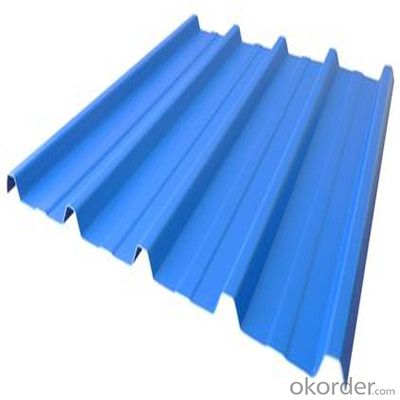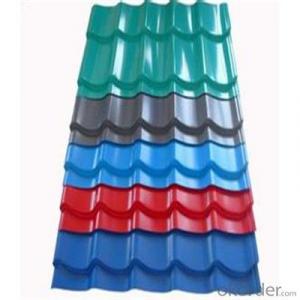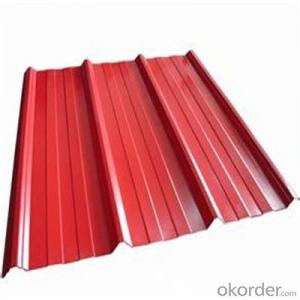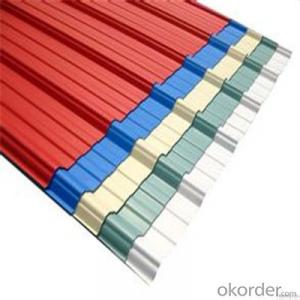Zinc Galvanized Corrugated Steel Iron Zinc Roof Sheets
- Loading Port:
- Shanghai
- Payment Terms:
- TT OR LC
- Min Order Qty:
- 50 m.t.
- Supply Capability:
- 1000000 m.t./month
OKorder Service Pledge
OKorder Financial Service
You Might Also Like
Item specifice
Description of Prepainted Corrugated Iron Sheet:
1. Hot-dipped galvanized
2. Color: All RAL color
3. Thickness: 0.23-1.0MM
4. Developed Width: 600mm to1200mm
Specifications of Prepainted Corrugated Iron Sheet:
1) Buildings and constructions: roofing, ceilings, gutters, venting lines, indoor decorations, window frames, etc.
2) Electrical appliances: computer shells, washing machines, refrigerators, dehumidifiers, video recorders, water heaters, etc.
3) Agricultural equipments: troughs, feeding tools, agricultural driers, irrigation channels, etc.
4) Vehicle parts: back-seat plates of buses and trucks, conveying systems, oil tanks, etc.
Features of Prepainted Corrugated Iron Sheet:
(1) Novel and beautiful modeling , rich luster, strong adornment sex, flexible in combination, can express different architectural styles;
(2) Light weight (6 ~ 10 kg/m squared) high strength (yield strength 250 ~ 550 mpa) fine skin stiffness,fine seismic performance of waterproofing agent;
Images of Prepainted Corrugated Iron Sheet:

FAQ:
1. What's the Delivery port?
The main ports are Qingdao and Tianjin, we also can deliver to other ports to meet your requirements
2. How long is the lead time?
Delivery time: 45 days after order confirmed.
3. What payment term do you accept?
Payment: T/T or L/C at sight.
- Q:Are steel sheets suitable for manufacturing elevator doors?
- Yes, steel sheets are suitable for manufacturing elevator doors. Steel is a popular choice for elevator doors due to its strength, durability, and aesthetic appeal. Steel sheets offer the necessary strength and rigidity required for elevator doors, ensuring safety and security. Additionally, steel is resistant to wear and tear, corrosion, and fire, making it a reliable material for elevator doors. Steel sheets can also be easily customized and finished to meet various design requirements, allowing for a wide range of styles and finishes. Overall, steel sheets provide the necessary qualities for manufacturing elevator doors, making them a suitable choice for this application.
- Q:Can the steel sheets be used for magnetic shielding?
- Steel sheets have the ability to be utilized for magnetic shielding. Due to its ferromagnetic nature, steel can effectively redirect and absorb magnetic fields. By utilizing steel sheets for shielding against magnetic fields, a barrier is created which aids in preventing the intrusion of magnetic flux into a specific area. This characteristic makes steel sheets a superb option for applications where magnetic shielding is necessary, such as in electronics, medical devices, and sensitive laboratory equipment. However, the effectiveness of steel sheets for magnetic shielding may be influenced by various factors, including the thickness and composition of the steel, as well as the strength and frequency of the magnetic field being shielded. Thus, it is crucial to consider these factors and seek guidance from experts to ensure the appropriate steel sheets are chosen for optimal magnetic shielding.
- Q:Can steel sheets be used in the construction industry?
- In the construction industry, steel sheets are commonly employed. These sheets are incredibly versatile and find extensive use in construction. They serve various purposes, including roofing, wall cladding, flooring, and structural components like beams, columns, and trusses. Steel sheets are favored owing to their exceptional strength-to-weight ratio, durability, and resistance to corrosion. They possess the ability to endure heavy loads and offer stability and structural integrity to buildings. Moreover, steel sheets can be easily fabricated, enabling customization and facilitating efficient construction processes. All in all, steel sheets are widely embraced in the construction sector due to their numerous advantages and suitability for diverse construction applications.
- Q:Can steel sheets be used for marine applications?
- Yes, steel sheets can be used for marine applications. Steel is often used in the construction of ships, barges, offshore platforms, and other marine structures due to its strength, durability, and resistance to corrosion in saltwater environments.
- Q:Can steel sheets be used in marine applications?
- Yes, steel sheets can be used in marine applications. Steel is a popular material choice for marine applications due to its high strength and durability. It can withstand the harsh conditions of saltwater and is resistant to corrosion. Steel sheets are often used in the construction of ships, offshore platforms, and other marine structures. They provide structural integrity and can be easily fabricated to meet specific design requirements. Additionally, steel sheets can be coated with protective layers, such as anti-corrosion paints or galvanization, to further enhance their resistance to corrosion in saltwater environments. Overall, steel sheets are a reliable and commonly used material in various marine applications.
- Q:Are steel sheets suitable for architectural mesh applications?
- Yes, steel sheets are suitable for architectural mesh applications. Steel sheets offer durability, strength, and versatility, making them an excellent choice for architectural mesh applications. They can be easily shaped, cut, and formed into various designs, allowing for the creation of intricate and aesthetically pleasing architectural mesh structures. Additionally, steel sheets can withstand harsh weather conditions and provide excellent security, making them a reliable option for architectural applications.
- Q:What is a fixed length steel plate?
- Please check the standard: GB/T706-2008 hot-rolled steel fixed length is in accordance with customer requirements made of length, usually 6 meters, 9 meters look
- Q:What is the difference between a HRPO and HRSPO steel sheet?
- The main difference between a HRPO (Hot Rolled Pickled and Oiled) and HRSPO (Hot Rolled Skin Pass) steel sheet lies in the manufacturing process and the resulting properties of the two types of sheets. HRPO steel sheets are produced by hot rolling a steel slab and then subjecting it to a pickling process where the surface scale is removed using an acid bath. After pickling, the steel sheet is then oiled to provide a protective coating. The pickling process imparts a clean, smooth surface to the sheet, while the oiling helps prevent corrosion and improve formability. HRPO sheets are typically used in applications that require good surface finish and paintability. On the other hand, HRSPO steel sheets undergo an additional skin pass rolling process after pickling and oiling. This process involves passing the sheet through a set of rolls to further improve its surface quality, resulting in a smoother and more uniform surface finish compared to HRPO sheets. The skin pass process also imparts better flatness and dimensional accuracy to the sheet. HRSPO sheets are commonly used in applications that demand higher surface quality, such as automotive panels, appliances, and electrical enclosures. In summary, while both HRPO and HRSPO steel sheets are pickled and oiled, the additional skin pass rolling step in the manufacturing process of HRSPO sheets enhances their surface quality, flatness, and dimensional accuracy, making them suitable for more demanding applications.
- Q:What is the difference between a smooth and embossed steel sheet?
- A smooth steel sheet is characterized by its flat and uniform surface, lacking any textures or patterns. It is typically produced by rolling the steel through a series of rollers to achieve a sleek and even finish. Smooth steel sheets are commonly utilized in industries where a seamless and polished appearance is desired, such as in architectural and interior design, automotive manufacturing, and appliance production. On the other hand, an embossed steel sheet possesses a textured or patterned surface. This texture is created by pressing the steel sheet between embossing rollers, which imprint a design onto the surface. The embossed pattern can take various shapes, including diamonds, squares, or waves, and it adds a decorative and tactile element to the sheet. Embossed steel sheets are often employed in industries like furniture manufacturing, signage production, and decorative metalwork. In terms of functionality, smooth steel sheets are typically chosen for applications that require a clean and unadorned surface, such as for painting, coating, or other surface treatments. They serve as a blank canvas for further customization or finishing processes. In contrast, embossed steel sheets provide a visually appealing and distinctive texture that can enhance the aesthetic appeal of a product or structure without the need for additional surface treatments. Furthermore, the surface texture of a smooth steel sheet tends to be more resistant to fingerprints, smudges, and dirt accumulation compared to an embossed steel sheet. This makes smooth steel sheets easier to clean and maintain in applications where cleanliness is crucial, such as in the food processing or healthcare industries. Overall, the primary distinction between a smooth and embossed steel sheet lies in their appearance, functionality, and suitability for specific applications. While smooth steel sheets offer a clean, consistent, and versatile surface, embossed steel sheets provide a decorative and textured finish that can elevate the visual appeal of a product or structure.
- Q:What are the common applications of steel sheets?
- Steel sheets are commonly used in a wide range of applications such as automotive manufacturing, construction, infrastructure projects, appliances, shipbuilding, and the production of various metal components.
1. Manufacturer Overview |
|
|---|---|
| Location | |
| Year Established | |
| Annual Output Value | |
| Main Markets | |
| Company Certifications | |
2. Manufacturer Certificates |
|
|---|---|
| a) Certification Name | |
| Range | |
| Reference | |
| Validity Period | |
3. Manufacturer Capability |
|
|---|---|
| a)Trade Capacity | |
| Nearest Port | |
| Export Percentage | |
| No.of Employees in Trade Department | |
| Language Spoken: | |
| b)Factory Information | |
| Factory Size: | |
| No. of Production Lines | |
| Contract Manufacturing | |
| Product Price Range | |
Send your message to us
Zinc Galvanized Corrugated Steel Iron Zinc Roof Sheets
- Loading Port:
- Shanghai
- Payment Terms:
- TT OR LC
- Min Order Qty:
- 50 m.t.
- Supply Capability:
- 1000000 m.t./month
OKorder Service Pledge
OKorder Financial Service
Similar products
New products
Hot products
Related keywords






























